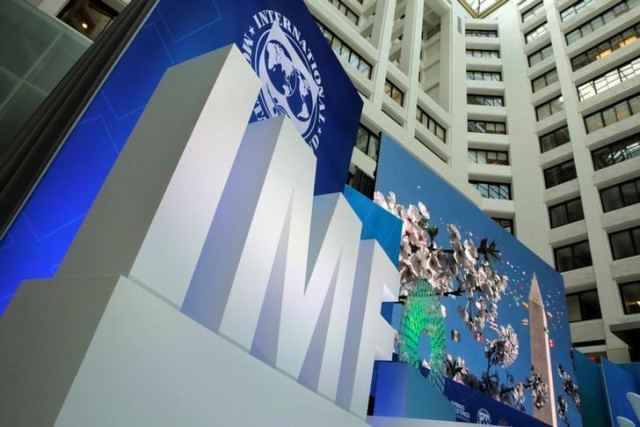IMF data bloats Pakistan forex reserves by $3bn
Gaps between its projections and actual results expose lender to criticism

The International Monetary Fund logo is seen during the IMF/World Bank spring meetings in Washington, US. PHOTO: REUTERS
However, the IMF’s data released late last week suggested that Pakistan’s external financing requirements would rise to $17 billion in the next fiscal year, but the global lender did not show any negative implication on the official forex reserves.
On June 16, the IMF issued a communiqué after concluding Article IV consultations, showing official foreign currency reserves to be at $18.5 billion by the end of this fiscal year. However, the figure appeared totally off the mark.
Global lender warns of risks to Pakistan’s economic stability
As of June 9, forex reserves held by the State Bank of Pakistan (SBP) stood at $15.3 billion, the central bank’s data showed.
It is highly unlikely that the country will be able to increase the reserves level to $18.5 billion over the next two weeks, particularly at a time when the reserves have come under massive pressure because of rising trade deficit.
The $15.3 billion foreign currency reserves are also $5.5 billion less than what the IMF had projected in its 12th review report on Pakistan’s economy, released in October last year.
PML-N will not need another IMF bailout, says Dar
Independent experts and sources in the Finance Ministry said that such huge variations in projections demonstrated that Pakistan’s external account was deteriorating at a much rapid pace than projected by both the IMF and Pakistan government.
Instead of addressing structural issues, which would have attracted non-debt creating inflows, the Finance Ministry preferred to obtain expensive foreign loans for inflating its reserves, they said, adding that this practice was now proving to be costly.
“Projections were made in the context of Article IV discussions in early April based on current account trends and expected financing at that time,” said an IMF spokesman in response to a query.
Hefty tax breaks result in whopping Rs415.8b dent
During the three-year period of the $6.2 billion IMF programme, the global lender struggled to project near-reality picture of exports, imports, external debt and current account deficit. The huge gap between its projections and end-year results exposed the country to many risks.
For the outgoing fiscal year 2016-17, the IMF had originally projected the current account deficit at 1.5 per cent of Gross Domestic Product (GDP) or equivalent to $4.5 billion. However, now it has revised the deficit projection to over $9 billion, which is double than the original projection, bringing the foreign currency reserves under pressure.
Reliance on borrowing: Cost of public debt eats up 45% of revenues
At the beginning of the fiscal year, independent economists said that current account deficit would be close to $8 billion by the end of the fiscal year 2016-17 but Finance Minister Ishaq Dar dismissed their projections.
New fiscal year’s projections
For the new fiscal year, IMF’s detailed note suggests that Pakistan’s external financing requirements would touch an unprecedented $17 billion. In its June 16 note, IMF had stated that Pakistan’s current account deficit would be 3.2 per cent of GDP, or $10.6 billion.
However, in its Annual Plan 2017-18, the federal government put the current account deficit at $8.6 billion, or $2 billion lower than IMF’s projections and $4.4 billion lower than the projections of independent economists.
Moreover, external debt repayments for the new fiscal year have been projected at $6 billion, bringing the total financing requirements to $17 billion.


















COMMENTS
Comments are moderated and generally will be posted if they are on-topic and not abusive.
For more information, please see our Comments FAQ